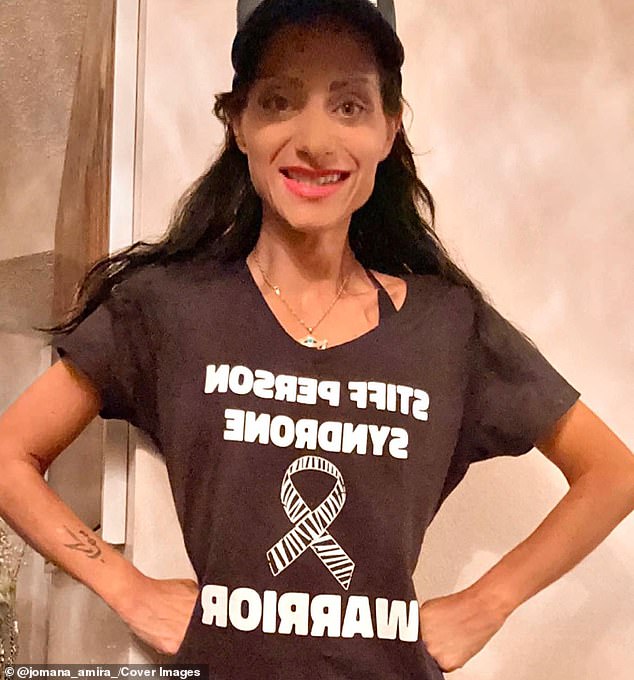I have the same one-in-a-million ‘stiff person syndrome’ that Celine Dion is battling – it could turn me into a ‘human statue’ at any time
A 31-year-old woman has opened up about how she suffers from the same ‘stiff person syndrome’ that Celine Dion is battling.
Jomana Houssari from Florida developed the rare condition in 2018, which causes stiffness and spasms all over her body, turning her into a “human statue.”
The aspiring police officer said she will eventually end up in a wheelchair, but is determined to “make the most of the time she has left” and raise awareness of her condition.
Celine was forced to pause her world tour and step back from her singing career in December 2022 after revealing she was suffering from the same incurable condition, which is believed to affect one in a million people.
She made a shocking appearance at the 2024 Grammys yesterday, walking onstage with the support of eldest son Rene-Charles Angelil, 23, to cheers and a standing ovation, and presenting Album of the Year to Taylor Swift, who then went on to win fire came to social media. for allegedly ‘blinding’ Celine.
Jomana Houssari from Florida developed the rare condition in 2018, which causes stiffness and spasms all over her body, turning her into a ‘human statue’

Celine made a shocking appearance at the 2024 Grammys yesterday (pictured), walking on stage with the support of eldest son Rene-Charles Angelil, 23, to cheers and a standing ovation, presenting Album of the Year to Taylor Swift , which subsequently came under fire. on social media for allegedly ‘whitewashing’ Celine
Stiff Person Syndrome is a progressive and incurable neurological disorder in which the body attacks nerve cells, causing spasms and stiffness.
Early signs of the condition include painful muscle contractions in the legs and back. Spasms can also affect the abdomen, arms and face.
This can lead to a stiff posture, difficulty walking and falls. More women are affected than men and symptoms are most common in people between the ages of 40 and 50.
It is unclear what causes ‘stiff person syndrome’, but it is thought to be an autoimmune disease – where the body’s immune system attacks healthy tissues.
Most people with the condition have unique antibodies in their blood that disrupt neurotransmitters in the brain, causing spasms and contractions.
Ms Houssari told DailyMail.com she was diagnosed with stiff person syndrome after 20 operations to repair damage caused by a car accident. It is unclear whether the surgeries are related to her diagnosis.
She already suffered from several autoimmune and neurological disorders, including Guillain-Barre syndrome, which causes the immune system to attack the nerves and eventually paralyze the entire body.

Ms Houssari has had medical problems since birth, but her SPS symptoms started after she underwent surgery to repair damage suffered in a serious car accident. After the wreck, she underwent more than twenty operations

Before her diagnosis, Ms. Houssari studied criminal justice and aspired to become a police officer
Ms Houssari asked her doctors to test her for ‘stiffness syndrome’ after she suffered from spasms.
Although the condition is difficult to diagnose, blood tests, scans and a lumbar puncture, where a sample of cerebrospinal fluid is taken from the spinal column, can rule out other conditions and spot signs of the condition.
“It was a month-long wait for the results, but it was finally confirmed that I did indeed have stiffness syndrome,” Ms Houssari said.
“Getting the diagnosis was a relief, but thinking about the future is quite scary,” Ms Houssari said.
‘Right now my symptoms include muscle spasms all over my body. When these episodes occur, I become a human statue and feel stiffness in my chest, face, arms, legs and back.

Ms. Houssari is just one of 330 Americans with stiff person syndrome. When she was first diagnosed, her doctor had never experienced the condition


Ms Houssari fears the day her condition will leave her in a wheelchair, but she says she is determined to make the most of the time she has left.
“In addition, I have been experiencing slurred speech, memory problems, random fits of laughter followed by fainting spells, general weakness, tingling in my head and body, and insomnia.”
Sometimes her spasms have led to broken bones.
The symptoms have forced her to abandon her criminal justice studies and have robbed her of what most would consider a “normal” life.
Controlling her condition requires a rigorous routine of infusions every three weeks and twice-daily doses of baclofen (a muscle relaxant) to relieve the spasms. She also takes potassium pills and thyroid medication.
“I face challenges in almost every aspect of my life, but I am determined not to give up,” she said.
‘Every little step forward gives me an incredible feeling of achievement. I have achieved things I never thought possible when I first became disabled.
“I cherish every moment, whether I’m sitting by the pool, enjoying scary movies on Netflix, or taking a walk along the beach on the days I have the strength, collecting shells along the way.”
Ms Houssari said doctors have told her her condition will worsen, eventually leaving her in a wheelchair.
“I dread the day I end up in a wheelchair,” she said. “Until then, I am determined to make the most of the time I have left and raise awareness about SPS by sharing my story.”
